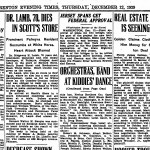 Picturesque Palmyra on the Delaware is a diminutive pamphlet which was used by various civics groups and public officials during the 1920s in order to promote a favorable image among the public toward Palmyra, with the objective of attracting investors, especially home buyers and business investors. It was an unabashed public relations piece, a kind of infomercial in 48 tiny pages, authored by a Dr. R.H. Lamb, whose grand mustachioed photo appears on the index card sized booklet.
Picturesque Palmyra on the Delaware is a diminutive pamphlet which was used by various civics groups and public officials during the 1920s in order to promote a favorable image among the public toward Palmyra, with the objective of attracting investors, especially home buyers and business investors. It was an unabashed public relations piece, a kind of infomercial in 48 tiny pages, authored by a Dr. R.H. Lamb, whose grand mustachioed photo appears on the index card sized booklet.
 Immodestly subtitled, “One of the Most Beautiful and Desirable Suburban Towns in New Jersey,” the pamphlet extols the many virtues of the flourishing borough as it existed in 1923. The best real estate advice about buying property was then, and still is, all about location. Accordingly, Picturesque Palmyra touts that all important key factor for home buyers by mentioning the easy access to Camden and Philadelphia by rail, trolley, and ferry. It further promises “all the advantages without the disadvantages of the city.”
Immodestly subtitled, “One of the Most Beautiful and Desirable Suburban Towns in New Jersey,” the pamphlet extols the many virtues of the flourishing borough as it existed in 1923. The best real estate advice about buying property was then, and still is, all about location. Accordingly, Picturesque Palmyra touts that all important key factor for home buyers by mentioning the easy access to Camden and Philadelphia by rail, trolley, and ferry. It further promises “all the advantages without the disadvantages of the city.”
Among a long list of Palmyra’s advantages listed are its rapid population growth, well-maintained homes, the “majestic Delaware,” the “picturesque Pensauken Creek” (sic), and its “fertile and productive” soil. The population of about four thousand is tagged as “middle class’’ and “…satisfied to dwell here forever in contentment and happiness.”
At a time when many of its readers could very well recall the 1918 influenza epidemic five years earlier, which afflicted over 25 percent of the U.S. population and killed thousands, the promise of Palmyra’s healthfulness “…unexcelled in any part of the state” may have been a claim of considerable importance. Even the weather cooperated to create this Utopia on the Delaware, with rarely occurring fog and quickly melting snow. After how long it has taken the accumulated snow from the last three snows of winter 2010-2011 to finally melt here, that sounds like a nice option.
Abundant artesian well water, “…cold, limpid, pure, and healthful,” supplied the household and emergency needs. Lamentably, as your water company will confirm, because of the effects of the gradual intrusion of the salt line moving up the Delaware, Palmyra and adjacent communities have not enjoyed artesian well water for many years.
 Dozens of photographs, many of which are full page images, confirm the booklet’s claims of well-kept homes on gravel- coated tree-lined streets having cement sidewalks. Within a mile and a half stood at least ten houses of worship plus several fraternal and patriotic organizations. The educational facilities “…unexcelled by any town of its size adjacent to Philadelphia” included a brick schoolhouse for primary and middle grade students plus a high school.
Dozens of photographs, many of which are full page images, confirm the booklet’s claims of well-kept homes on gravel- coated tree-lined streets having cement sidewalks. Within a mile and a half stood at least ten houses of worship plus several fraternal and patriotic organizations. The educational facilities “…unexcelled by any town of its size adjacent to Philadelphia” included a brick schoolhouse for primary and middle grade students plus a high school.
Palmyra sustained a remarkable number and variety of businesses listed on page 33: several grocers and markets including Acme, A&P, and American Stores, two drug stores, two hardware stores, several dry goods stores, two bakeries, a restaurant, a theater, a newspaper, a store just for hats, a bank, and three garages. Of course, there is a also large real estate ad for Dr. Lamb at 429 Horace Avenue, and a smaller dentistry ad for his practice at the same address. It was a different time; a different economy. Most people generally made purchases close to home.
Dr. Lamb’s real estate holdings were indeed considerable, containing more than twelve acres of building land situated between the railroad and the river, near the high school. Readers were assured that the demand for houses was beyond the supply, that property values had been on the increase, and that a real estate boom was imminent. Then, as today, “Buy now,” was the not-so-subtle message.
Dr. Lamb thoughtfully pointed out that, between Riverton and Palmyra, there were three building and loan societies through which borrowers could pay off a home loan in eleven years. Sweet! We are invited to visit in order to verify that, “It’s All Here and It’s All True.”
 An examination of the two-page business directory at the end of the publication shows only one enterprise which has survived to the present—a small advert for H.C. Schwering’s Hardware. At the time of the booklet’s 1923 publication, Schwering’s Wayside Hardware had only been open a matter of months. Way to go Schwering’s! I am looking forward to your centennial celebration in 2022.
An examination of the two-page business directory at the end of the publication shows only one enterprise which has survived to the present—a small advert for H.C. Schwering’s Hardware. At the time of the booklet’s 1923 publication, Schwering’s Wayside Hardware had only been open a matter of months. Way to go Schwering’s! I am looking forward to your centennial celebration in 2022.
Today’s public relations agents who write advertising copy might learn a thing or two from the good Spin Doctor Lamb. Understandably, his motive for producing this piece of positive Palmyra propaganda was for profit. Presumably, he did, for Palmyra is today, like Riverton, fully developed. However, it can be inferred from his direct and earnest tone and, from his own choice to live and work in the same community, that his investment in the community was wholehearted and sincere.


Dr. Lamb’s experience, however, extended far beyond the boundaries of Palmyra borough. When he passed away suddenly, of heart trouble December 12, 1929, he had been on his way to inspect his real estate development in New Egypt, NJ. An article in the Trenton Evening Times reporting his death, and a later obituary in the same newspaper, characterized him as a prominent physician, real estate developer, noted traveler, and curio collector who had lived in 60 different countries.
A listing in a 1906 biographical sketch book, The Natal Who’s Who, indicates that the ancestry of Dr. Ridgeway Haines Lamb “…extends through 1,000 years of English history, including about 20 generations of Royalty. A lineal descendant of ‘Alfred the Great.’” It noted that the Philadelphia Dental College graduate had “…practiced in every continent upon the globe” and was a “Pioneer of American Dentistry in many countries,” including India, Ceylon, Malaysia, Afghanistan, Japan, the Orient, and the South African cities of Natal, and Durban.

While a resident in Africa, he published a slim 30 page attack on Natal officialdom in 1906, Hard Times in Natal and the Way Out. He wrote a number of articles and treatises for professional dentistry publications while abroad and, after returning to America, lectured with stereopticon illustrations of Japan and Ceylon.
I know what you’re thinking. Really? Sixty countries? Alfred the Great?
Obviously, an accomplished self-promoter, as well as a devoted Palmyra booster, Dr. Lamb’s life reads like a plot outline for a Hollywood blockbuster. But that is no reason to suspect that it is fiction. Googling for any scrap of information on him, incredibly, this confirmation came from an Internet source halfway around the world in a Singapore newspaper database.
An October 1910 article in The Straits Times announced, “Something New in Singapore,” with the opening of Dr. R.H. Lamb’s new dental practice. Ever the entrepreneur, Dr. Lamb advertised his practice in a September 1911 issue of Singapore’s Weekly Sun along with a dentifrice of is own composition, Teaberry Tooth Powder. From this June 1913 ad in The Straits Times, advising that the doctor had just returned to resume his practice on Coleman Street, having returned from Borneo and the Philippines, it may be inferred that he visited other Far East destinations during his stay in Singapore .

A February 1913 Weekly Sun ad solicited buyers for a 3½″x6″ souvenir booklet of Singapore. Could this small 48 page pamphlet have been a dress rehearsal for Picturesque Palmyra? Altogether, there were dozens of other advertisements for Dr. R.H. Lamb in three different Singapore newspapers published from 1910– 1914. Presumably, he returned to America when the ads ceased in May 1915.
His obituary in the Trenton Evening Times referred to a pagoda built by Dr. Lamb in which to house and display his very large and unique curio collection, acquired as a result of his world travels. Doubtless, the photo on page 31, captioned “Pagoda—Lamb’s Extension” is that shrine to his globe-trotting adventures.
The 1926 Burlington County Directory lists Lamb as “retired,” living at 429 Horace Street, Palmyra. At the same address is his wife, Kathryn, his son Howard R. Lamb (no occupation), and daughter, Bermuda Lamb, a nurse. If any reader has more information or photos about Dr. Ridgeway Haines Lamb, his real estate interests in Palmyra or elsewhere, writings, lectures, his descendants, or any other aspect of this extraordinary gentleman’s life, please comment or contact us so that this saga may be made more complete.
A sincere thank you to Palmyra Cultural and Historical Society President, Jim May, for generously permitting me to scan his copy of Picturesque Palmyra, and to HSR Board member and professional historian, Paul W. Schopp, for providing the two Trenton Evening Times newspaper clippings.— John McCormick, Gaslight News editor
Click here to view a PDF file of the entire 48 page Picturesque Palmyra booklet. Be advised, it is a 6.63MB file. Viewing tip: After the file uploads to your computer, it will likely have the pages turned sideways. Hit your escape button which will take you out of the “full-screen” view. Then, right-mouse click anywhere on the image to choose “rotate clockwise” from a pop-up menu. Voila! Now you don’t have to turn on your head to look at the pages. – John McCormick, Gaslight News editor

My gr-grandmother, Rebecca (Lamb) Sharp, was R.H. Lamb’s 1st cousin. His brother, Dr. William Reeve Lamb, lived to be 109 (1859-1969). My grandfather, Charles Lamb Sharp, also lived in Palmyra in what was the Toy-Morgan House that overlooked the Delaware. His 2nd wife, Marion (Hurff) Sharp, lived there almost to her death at age 102.
Yes, we descend from the royals. The primary link is Anne (Mauleverer) Abbott, RH Lamb’s 4th gr-grandmother.
Malcolm Sharp
Rolling Hills, CA
I am glad you found us, Mr. Sharp, and hope you found the stay worthwhile. Whatta’ guy that Dr. Lamb was. Certainly a real mover and shaker who affected local development and, indeed local history in a real way. If you are aware of anything we missed, or have anything to add to our understanding of Palmyra, we would very much like to hear from you again.
Best regards,
John McCormick
I lived on Garfield Ave. in Cinnaminson. I recall Dr. William Reeve Lamb. He resided in the 600 block of Garfield. Though at the time of his passing I would have been 8 years old. I knew he was very old, but not 109! I saw someone who was alive and possibly could recall THE CIVIL WAR and LINCOLN’S ASSASINATION!
There was a Dr. Lamb who lived next to the old Palmyra Community Center on Garfield Ave. He looked just like the Dr. Lamb in your story. Everybody in town knew who he was and in the early 1960s he must have been in his 80s. He still wore a straw hat in the spring and suspenders. Until I read your article, I thought this was the Dr. Lamb who developed the land near PHS, but must have been a son or nephew.